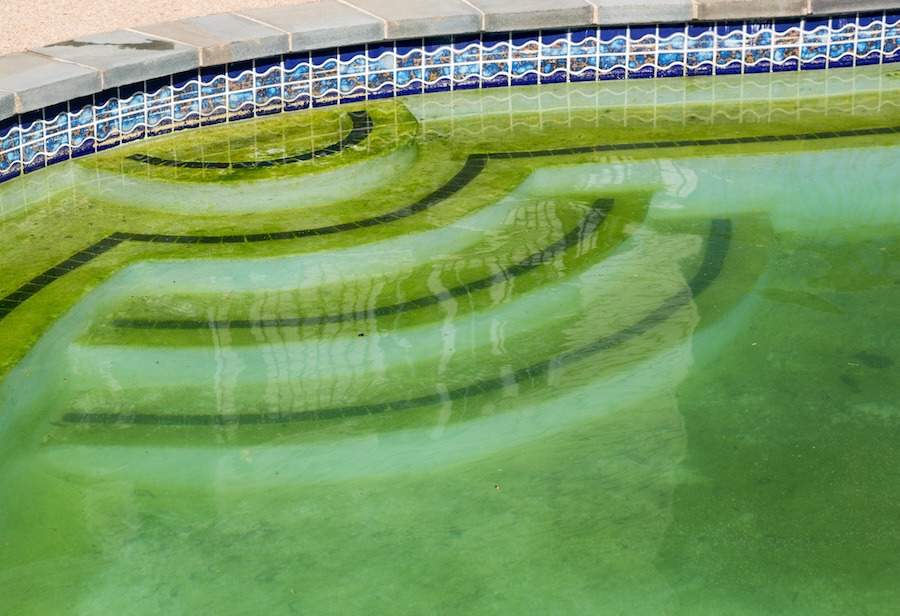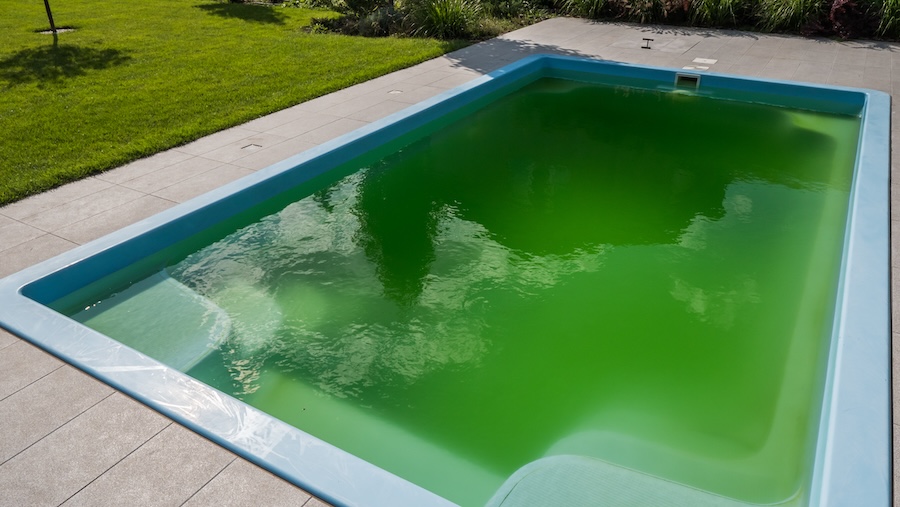Here’s the quick answer: The fastest way to eliminate algae involves four main steps. First, brush your pool surface and pool wall thoroughly to break up algae colonies. Second, balance your pool water chemistry, paying special attention to your pH level. Third, shock your pool at 2-3 times the normal dose. Fourth, run your pool filter and pool pump continuously for 24-48 hours, cleaning your filter cartridge as needed.
The dead algae will make your water cloudy at first, but you can vacuum it out once the treatment is complete. Stick with us as we dive deeper into the different types of algae you might face, detailed elimination strategies, and how to prevent future outbreaks.

Know Your Enemy: Understanding Different Types of Pool Algae
Not all algae are created equal. Identifying what’s growing in your pool helps you choose the right treatment approach and set realistic expectations for how long the cleanup will take.
Green Algae: The Most Common Culprit
Green algae is what most pool owners battle. It shows up as floating green pool water or clings to your pool wall and other surfaces. Algae spores enter your swimming pool through wind, rain, contaminated swimsuits, or even on pool toys. When conditions are right (low chlorine level, stagnant water, or hot weather), these spores multiply rapidly into a full-blown algae bloom.
Mustard Algae (Yellow Algae): The Stubborn Return Visitor
Mustard algae appears as yellowish-brown patches that many pool owners initially mistake for dirt or sand. It brushes away easily, which seems promising until it returns a few days later. This type is more resistant to chlorine than green algae and loves shaded areas and crevices in your pool wall.
Yellow algae requires a more aggressive approach with higher shock levels and often benefits from a phosphate remover to eliminate its food source.
Black Algae: The Toughest Opponent
Black algae is the villain of pool algae problems. It forms a protective layer that shields it from pool chemicals, and its root structure actually embeds into your pool surface. This makes it incredibly difficult to remove without aggressive brushing using a specialized pool brush.
Prevention is your best strategy with black algae because once it takes hold, you’re in for a battle. Many pool owners facing a serious black algae problem choose to call in professional help rather than wage war on their own.
Pink Algae: The Imposter
Pink algae isn’t actually algae at all but rather harmful bacteria. It appears as slimy pink or red streaks, typically in areas with poor circulation. While less common than other types, it’s worth mentioning because the treatment approach is similar to other algae varieties.

The Complete Algae Elimination Battle Plan
Ready to reclaim your pool? Follow these steps carefully for the best results.
Step 1: Assess and Prepare
- Test your pool water to check your current pH level, chlorine level, and cyanuric acid levels
- Remove any pool cover to ensure proper circulation during treatment
- Gather your supplies: a good pool brush, shock treatment materials, chlorine granules, and ideally a pool algaecide
Step 2: Brush Like You Mean It
- Brush thoroughly to break up algae colonies and that protective layer that helps algae resist chemicals
- Focus on your pool wall, steps, corners, and any textured surfaces where algae love to hide
- For black algae specifically, invest in a stainless steel pool brush that can penetrate the roots
- Don’t skip this step or do it halfheartedly, or your shock treatment won’t work as well
Step 3: Balance Your Chemistry
- Adjust your pH level to between 7.2 and 7.4 for maximum shock effectiveness
- Check that cyanuric acid isn’t too high (above 50 ppm can reduce chlorine effectiveness)
- Consider using a phosphate remover since phosphates are essentially fertilizer for algae growth
Step 4: Shock the Pool
Calculate how much pool shock you need based on your pool size and algae severity:
- Green algae: Use 2 times the normal shock dose
- Mustard algae: Use 3 times the normal shock dose
- Black algae: Use 4 times the normal shock dose plus daily brushing
Shock in the evening or at night to prevent the sun from degrading the chlorine before it can do its job. After shocking, you want your chlorine level to reach 10-30 ppm depending on the algae type.
Step 5: Filter and Clean
- Run your filtration system continuously for 24-48 hours so your pool filter can capture all that dead algae
- Clean or backwash your pool filter every 12 hours during this process
- If you have a cartridge filter, you may need to replace it entirely if it’s already due for replacement
Step 6: Add Algaecide
- Once your chlorine level drops back to normal (1-3 ppm), add a pool algaecide according to the manufacturer’s directions
- This helps prevent any surviving algae spores from recolonizing your pool
- Particularly helpful as a follow-up treatment for stubborn mustard algae or black algae
Step 7: Vacuum and Test
- Use your pool vacuum to remove any settled, dead algae from the bottom
- For a heavy algae problem, you might need to vacuum to waste (bypassing your filter) to avoid clogging it completely
- Once the water clears, test your pool water chemistry again and adjust as needed to maintain proper levels on a regular basis
Stop Algae Before It Starts
Winning the battle against algae is great, but preventing future algae outbreaks is even better. Here’s how to keep your pool sparkling year-round.
Maintain Proper Chemistry on a Regular Basis
Test your pool water at least once per week. Keep your chlorine level consistent between 1-3 ppm and your ph level between 7.2-7.6. Balanced water chemistry is your first line of defense against algae growth. Think of it like brushing your teeth daily instead of waiting for a cavity.
Keep the Water Moving
Run your pool pump 8-12 hours daily depending on your pool size and the season. During hot weather or after a pool party, you might need to run it even longer. Your filtration system can’t remove algae spores if the water isn’t moving through it. Address any dead zones where poor circulation allows algae to establish a foothold.
Regular Maintenance Matters
Brush your pool weekly even when it looks clean. This prevents algae from getting a grip on your pool surface. Clean your filter cartridge on a regular basis according to the manufacturer’s recommendations. Skim leaves and debris promptly since organic matter harbors algae spores and provides food for algae growth.
Plan Around Pool Parties
Before hosting a pool party, shock your pool. After the party, test and shock again if needed. Extra swimmers introduce algae spores, sunscreen, and other contaminants while depleting your chlorine. A little prevention before and after saves you from dealing with cloudy water or green water the following week.
Watch the Weather
Hot weather accelerates algae growth dramatically. Heavy rain dilutes your pool chemicals and can drop your chlorine level to nearly zero. After storms, test your water and rebalance immediately rather than waiting for your normal testing day.

When to Call in the Professionals
Sometimes DIY approaches fall short, and that’s completely okay. Here are signs you might benefit from professional help:
You’ve treated your pool multiple times but the algae problem persists. You’re battling black algae that refuses to budge. You have an algae outbreak right before a major pool party and don’t have time to handle it yourself. You’re unsure about proper water chemistry and don’t want to risk damaging your pool or wasting money on the wrong pool chemicals.
The Net Positive Pools Advantage
At Net Positive Pools, we see algae problems every single day. Our team knows exactly which treatment works for each type of algae and has access to professional-grade equipment that makes short work of even stubborn cases. Our “Green to Clean” service specializes in bringing severely neglected pools back to life.
Beyond just treating your current situation, we offer weekly maintenance packages that prevent future problems. Our team handles filter cleaning (including cartridge filter maintenance), water testing, chemical balancing, and all the other tasks that keep your pool in perfect condition on a regular basis.
We serve pool owners across North Carolina, South Carolina, and Georgia, and our goal is simple: we handle the science so you can handle the fun.
Get Back to Enjoying Your Pool
Fighting an algae problem doesn’t have to consume your weekends or your sanity. Your swimming pool should be a source of joy and relaxation for your family, not another chore on your to-do list. Professional pool service often saves money compared to the trial-and-error approach of buying various pool chemicals and equipment you might not need.
Ready to say goodbye to that green pool for good? Contact Net Positive Pools for a consultation. We’ll assess your specific situation and create a plan to get your pool back to its sparkling best. Life’s too short to spend your summer battling algae instead of making memories with family and friends.
